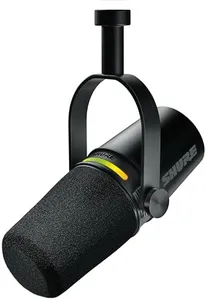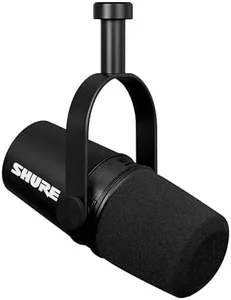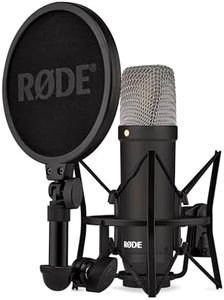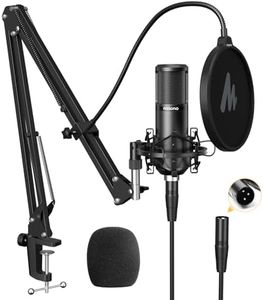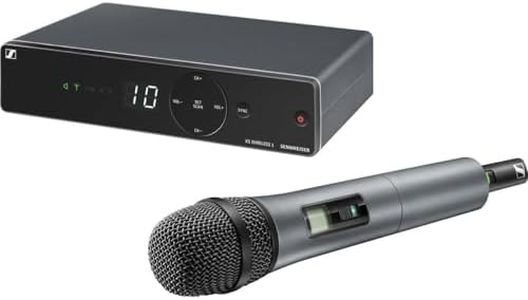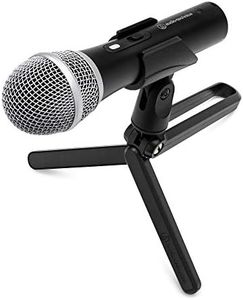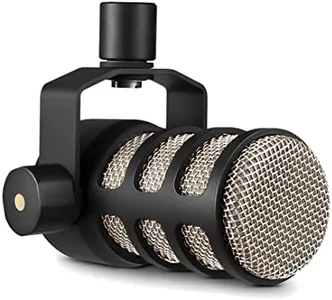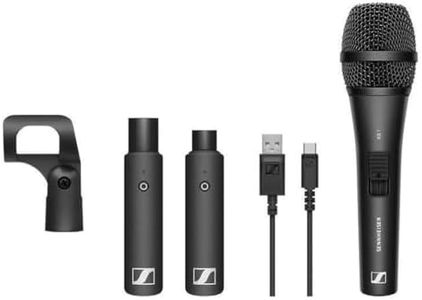10 Best Recording Microphones For Vocals 2025 in Canada
Our technology thoroughly searches through the online shopping world, reviewing hundreds of sites. We then process and analyze this information, updating in real-time to bring you the latest top-rated products. This way, you always get the best and most current options available.

Our Top Picks
Winner
Shure MV7+ Podcast Dynamic Microphone. OBS Certified, Enhanced Audio, LED Touch Panel, USB-C & XLR Outputs, Auto Level Mode, Digital Pop Filter, Reverb Effects, Podcasting, Streaming, Recording -Black
The Shure MV7+ is a dynamic microphone designed especially for podcasting, streaming, and vocal recording. It uses a unidirectional polar pattern, which helps focus on your voice while reducing background noise—great for clear vocal recordings in less-than-ideal environments. The frequency response extends up to 20 kHz, covering the full vocal range to capture detailed, natural sound. Sensitivity is moderate, typical for dynamic mics, so it won’t pick up every faint noise, which can be a plus in noisy rooms.
It offers both USB-C and XLR connections, making it flexible for beginners using computers directly or for more professional setups with mixers. Build quality is solid metal, giving it durability, and the included foam windscreen helps reduce breath sounds. Unique to this mic are handy features like a colourful LED touch panel for controlling audio levels and muting, plus built-in digital effects like a pop filter and real-time noise reduction to improve sound quality without extra gear. The MV7+ also has an auto-level mode that adjusts gain based on your distance, helping keep your voice consistent.
One downside is the relatively high weight (about 870g), which might need a sturdy stand for comfortable use. Also, while the digital features are great for podcasters and streamers, musicians looking for pure, unprocessed sound might prefer a simpler mic. To sum up, the Shure MV7+ is an excellent choice for podcasters and streamers who want professional sound with easy setup and useful built-in tools. It nicely balances quality, versatility, and user-friendly features but may be a bit heavy and over-featured for some pure vocal recording fans.
Shure MV7X Microphone - XLR Only Pro Quality Dynamic Mic for Podcasting & Vocal Recording, Voice-Isolating Technology, All Metal Construction, Mic Stand Compatible, Optimized Frequency - Black
The Shure MV7X is a dynamic microphone designed specifically for vocal recording and podcasting, offering professional-grade sound quality. It uses a unidirectional (cardioid) polar pattern to focus on your voice while minimizing background noise, which is great for imperfect recording environments. Its dynamic cartridge is well-suited for capturing vocals with clarity and warmth.
The microphone connects exclusively via XLR, meaning it requires an audio interface or mixer with XLR inputs, which is common in professional setups but less convenient if you want a simple USB connection. The metal construction ensures durability and a premium feel, and it comes with adapters to fit most mic stands, making setup easy. The MV7X is optimized for voice, designed to capture vocal tones effectively without unnecessary highs or lows.
This microphone does not include a preamp or USB option, so it is ideal for users who already have or plan to use professional audio gear. It serves as a reliable, high-quality, budget-friendly choice for podcasting or vocal recording within such setups.
Shure SM58-LC Cardioid Dynamic Vocal Microphone with Pneumatic Shock Mount, Spherical Mesh Grille with Built-in Pop Filter, A25D Mic Clip, Storage Bag, 3-pin XLR Connector
The Shure SM58 is a dynamic microphone built mainly for vocal recording and live performances. It uses a cardioid polar pattern, which means it picks up sound primarily from the front, helping to reduce unwanted background noise—a big plus when recording vocals in less controlled environments. Its frequency response ranges from 50 Hz to 15 kHz, emphasizing vocal clarity with a brightened midrange that makes your voice sound clear and present. This tailored response is why many singers and podcasters trust it for reliable vocal reproduction.
Being an XLR microphone, it requires an audio interface or mixer with XLR inputs, which is common in professional setups but might need extra equipment if you want to connect it directly to a computer. The SM58 is known for its rugged metal build and includes a built-in pop filter to minimize breath and wind noise, reducing unwanted 'pops' during singing or speaking. It comes with a swivel stand adapter and a storage bag, plus a two-year warranty, adding value for those who frequently perform or record.
Dynamic microphones like the SM58 are generally less sensitive than condenser microphones, so they may not capture as much detail in very quiet or studio-controlled vocal recordings. However, this makes them excellent at handling loud sound sources without distortion and ideal for live situations or untreated rooms. The Shure SM58 provides a durable, dependable option for vocalists needing a microphone that excels in live settings and can also be used in studio environments. Its design focuses on clear vocal delivery and noise rejection, although for extremely detailed studio vocals, a condenser mic might be better suited.
